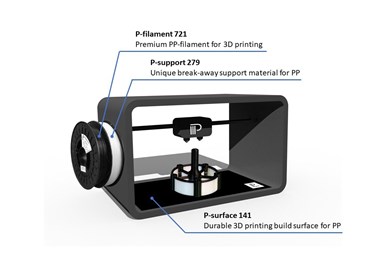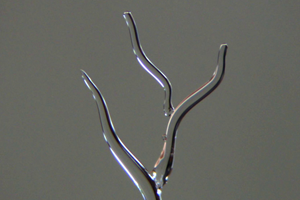New Materials Support Medical-Grade Polypropylene Extrusion
PPprint’s latest portfolio of polypropylene grades support extrusion AM use for custom medical parts, like orthotics and orthopedic aids.
Share

Polypropylene grades from PPprint meet the stringent material requirements for use in additively manufactured custom orthoses and orthopedic aids. Photo Credit: PPprint
While additive manufacturing’s elimination of retooling makes it attractive to assistive aid manufacturers customizing and personalizing products for individual patients, proper materials must achieve compatibility with additive manufacturing methods at high qualities before any manufacturing takes place. These materials must satisfy several chemical, biological and technical standards, with certain applications also requiring satisfaction of break resistance and flexibility standards. Other applications might call for the ability to easily clean or sterilize the material, or for suitability for skin contact.
The affordability and quality of 3D extrusion printers has made extrusion-based techniques like FDM and FFF dominant in the medical market, but established extrusion-based 3D printing materials like PLA and ABS don’t reach the required performance profile required for many medical applications. PPprint GmbH means to change matters with its polypropylene product portfolio.
Positive Points of Polypropylene
Polypropylene is one of the world's most-consumed plastics, and has already proven capable in many injection molding and extrusion applications across multiple industries — including medical. PPprint says recycling polypropylene is quick and efficient, making it attractive from a sustainability perspective, while its resistance to acids, bases, alcohol and water appeals to medical manufacturers. Several grades of polypropylene are skin-friendly and non-hazardous to health, and many grades are compatible with sterilization processes and can be cleaned manually or in a dishwasher.
Unfortunately, many polypropylene grades prove difficult to 3D print in terms of interlayer bonding, warpage, bed adhesion and reliable support materials. Solutions such as adhesive tapes or glues are not suitable for industrial applications, and turn many users away from using polypropylene. PPprint believes its product portfolio solves these issues and enables the reliable printing of high-quality polypropylene parts of any shape complexity and geometry.

PPprint is offering three unique grades of polypropylene for additive manufacturing: P-filament 721 for the main body, P-support 279 for supports and P-surface 141 for build plates. Photo Credit: PPprint
Solving Material Challenges
Successful extrusion-based printing of polypropylene requires a printed material with a low warpage and high interlayer bonding strength, a support material for overhangs and openings that can be easily removed from the finished part, and a 3D printing build surface that allows both reliable 3D printing of polypropylene parts and the non-destructive and residual-free removal of the finished part without any additional chemicals.
Building on its founders’ research experience with polyolefins, PPprint developed polypropylenes to solve these three challenges. The main product of PPprint’s portfolio is “P-filament 721,” which is available in the diameters of 1.75 mm and 2.85 mm. The filaments offer low warpage and very high interlayer bonding strength, with the “P-filament 721 natural” grade meeting DIN EN ISO 10993-5 biological safety certification requirements, which govern medical devices in contact with skin.
Next, PPprint developed its “P-surface 141” 3D printing build surface, which supports reliable and reproducible printing of polypropylene with simple, defect-free removal of 3D printed parts at elevated temperatures.
The third pillar of PPprint’s polypropylene catalog is “P-support 279,” a break-away support filament which enables the production of detailed and complex structures containing bridges, overhangs, and openings. This support material adheres very well to polypropylene printed parts as well as to “P-surface 141,” and can be easily and cleanly removed at elevated temperatures.
Polypropylene for Adaptive Aids
Adaptive aids such as orthoses or orthopedic aids enable individuals with physical injuries, mobility limitations or disabilities to live as independently as possible. These gadgets can increase a person's mobility, degree of function and capacity to execute daily tasks. Considering the variety of physical limitations that people may experience due to genetics, illness or injury, these devices must address an vast set of requirements while being adaptable to particular user-specific criteria. As a result, assistive aids must be highly customized to be effectively functional — making them prime candidates for additive manufacturing.

This 3D printed leg splint used P-filament 721 as the base, with P-support 279 as the break-away support material. The support is recyclable, promoting sustainability. Photo Credit: PPprint
One practical example of these polypropylene grades coming together is a 3D printed leg splint made from P-filament 721 and support material P-support 279. The support material provided high stiffness and low warpage while maintaining adherence to the printed polypropylene part and P-surface 141. The user could also print rafts and support structures on top of the printed part, then cleanly and easily remove the support material after heating up to 210° to 230°F (100° to 110°C). The break-away support did not require solvent or create an aqueous polymer containing waste, and still proved simple enough to recycle, promoting sustainability in several ways.
In short, extrusion-based 3D printing with polypropylene grades like those from PPprint enables unique, complex geometries that support the stabilization, immobilization, relief, guidance, or correction of different body parts and boost the healing process. With these geometries and materials, medical manufacturers can produce customized orthoses or orthopedic aids that are comfortable and effectively withstand mechanical stresses.
Related Content
FDA-Approved Spine Implant Made with PEEK: The Cool Parts Show #63
Curiteva now manufactures these cervical spine implants using an unusual 3D printing method: fused strand deposition. Learn how the process works and why it’s a good pairing with PEEK in this episode of The Cool Parts Show.
Read MoreActivArmor Casts and Splints Are Shifting to Point-of-Care 3D Printing
ActivArmor offers individualized, 3D printed casts and splints for various diagnoses. The company is in the process of shifting to point-of-care printing and aims to promote positive healing outcomes and improved hygienics with customized support devices.
Read MoreDurable, Waterproof 3D Printed Casts: The Cool Parts Show #58
Recovering from an injury with an ActivArmor cast means that patients can exercise, bathe and live life while they heal. We get a firsthand look at the solution in this episode of The Cool Parts Show.
Read MoreIce 3D Printing of Sacrificial Structures as Small as Blood Vessels
Using water for sacrificial tooling, Carnegie Mellon researchers have created a microscale method for 3D printing intricate structures small enough to create vasculature in artificial tissue. The biomedical research potentially has implications for other microscale and microfluidics applications.
Read MoreRead Next
3D Printing Brings Sustainability, Accessibility to Glass Manufacturing
Australian startup Maple Glass Printing has developed a process for extruding glass into artwork, lab implements and architectural elements. Along the way, the company has also found more efficient ways of recycling this material.
Read MoreAt General Atomics, Do Unmanned Aerial Systems Reveal the Future of Aircraft Manufacturing?
The maker of the Predator and SkyGuardian remote aircraft can implement additive manufacturing more rapidly and widely than the makers of other types of planes. The role of 3D printing in current and future UAS components hints at how far AM can go to save cost and time in aircraft production and design.
Read MoreHybrid Additive Manufacturing Machine Tools Continue to Make Gains (Includes Video)
The hybrid machine tool is an idea that continues to advance. Two important developments of recent years expand the possibilities for this platform.
Read More






















